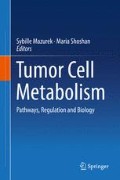The online version of the original chapter can be found under DOI 10.1007/978-3-7091-1824-5_2
You have full access to this open access chapter, Download chapter PDF
Keywords
These keywords were added by machine and not by the authors. This process is experimental and the keywords may be updated as the learning algorithm improves.
In a previous version of this chapter an incorrect figure was shown for Fig. 2.1. The correct Fig. 2.1 is shown below. The Publisher would like to apologize for this mistake. The original version of the chapter has been corrected accordingly online and in print (see DOI 10.1007/978-3-7091-1824-5_2).
Overview of oncogenesis of epithelial tumors. Oncogenesis takes place in context of the tumor microenvironment that includes oxygen tension, pH, nutrient supply, and interactions with other cell types in close proximity of the tumor, such as stromal cells and immune cells. Initiation begins with oncogenic mutations or epigenetic changes in expression of tumor suppressor genes and oncogenes of an epithelial cell, leading to alterations in cancer cell metabolism. Altered metabolism drives the establishment of a primary epithelial tumor which is initially contained within its tissue of origin. Some cancer stem cells undergo EMT, which makes them less sticky and more aggressive, breaking the basal membrane barrier and invading underlying tissues. Some of these mesenchymal tumor cells enter blood vessels (intravasation) and travel in the blood stream as circulating tumor cells. Once they leave the blood stream (extravasation), they form micrometastases in new tissues and organs. Once they undergo MET, they grow into macrometastases or secondary tumors of epithelial origin
Author information
Authors and Affiliations
Corresponding author
Editor information
Editors and Affiliations
Rights and permissions
Copyright information
© 2015 Springer-Verlag Wien
About this chapter
Cite this chapter
Berridge, M.V., Herst, P.M. (2015). Erratum to Chapter 2: Tumor Cell Complexity and Metabolic Flexibility in Tumorigenesis and Metastasis. In: Mazurek, S., Shoshan, M. (eds) Tumor Cell Metabolism. Springer, Vienna. https://doi.org/10.1007/978-3-7091-1824-5_16
Download citation
DOI: https://doi.org/10.1007/978-3-7091-1824-5_16
Publisher Name: Springer, Vienna
Print ISBN: 978-3-7091-1823-8
Online ISBN: 978-3-7091-1824-5
eBook Packages: Biomedical and Life SciencesBiomedical and Life Sciences (R0)


